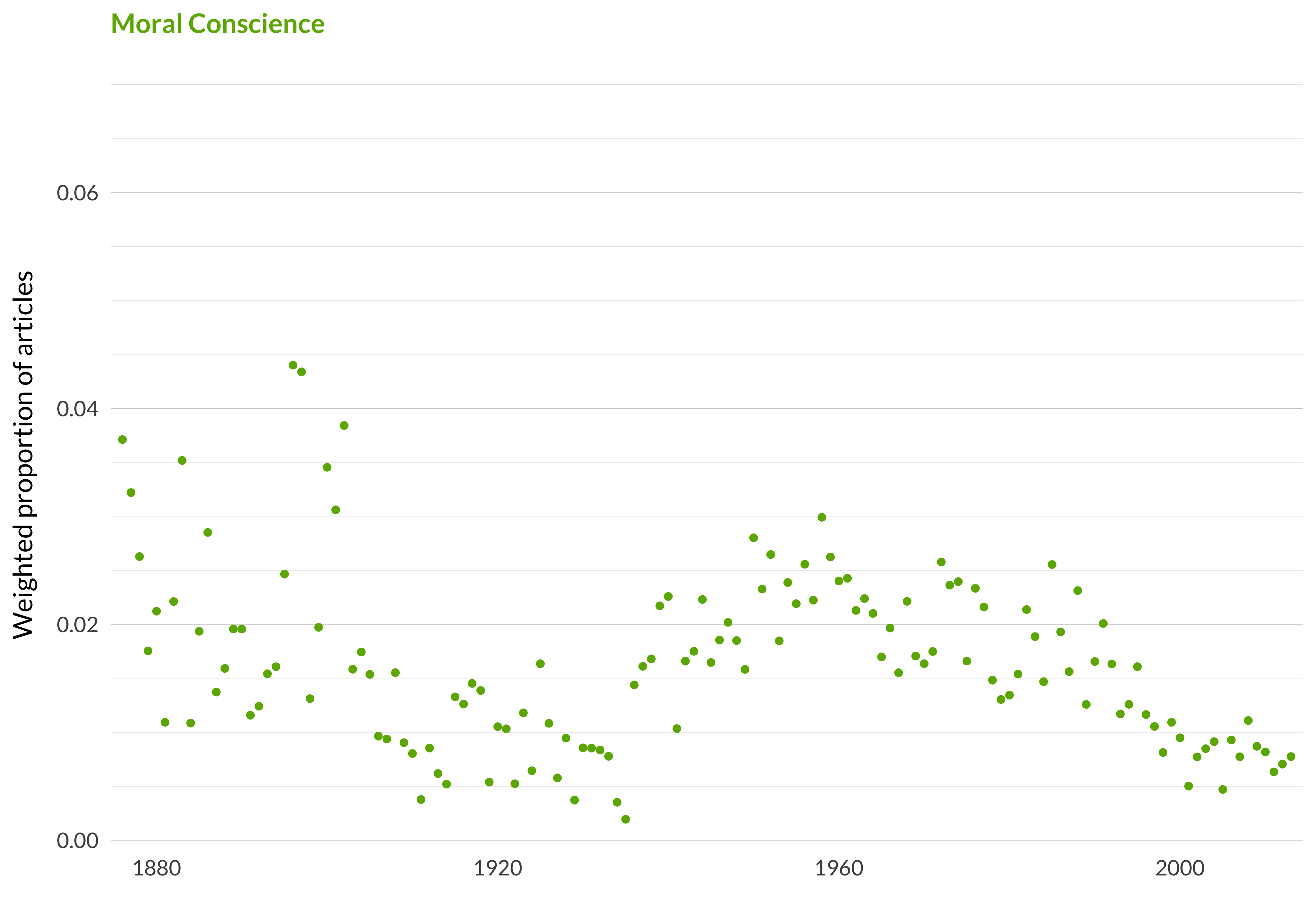2.25 Moral Conscience
Category: Ethics
Keywords: ethical, conscience, morality, moral, morals, ethics, conduct, morally, wrong, code, conflicts, approval, egoism, principles, conflict
Number of Articles: 669
Percentage of Total: 2.1%
Rank: 3rd
Weighted Number of Articles: 519.1
Percentage of Total: 1.6%
Rank: 11th
Mean Publication Year: 1963
Weighted Mean Publication Year: 1965.2
Median Publication Year: 1965
Modal Publication Year: 1959
Topic with Most Overlap: Ordinary Language (0.0645)
Topic this Overlaps Most With: Virtues (0.0588)
Topic with Least Overlap: Quantum Physics (0.00021)
Topic this Overlaps Least With: Models (0.00012)

Figure 2.64: Moral conscience.

Figure 2.65: Moral conscience articles in each journal.
Comments
I’ve called this moral conscience, though there are any number of other terms I could have used. Along with value, virtues and duties it forms the core of normative ethics. The division among these four topics is somewhat arbitrary, and it isn’t wrong to see them as really forming one large topic.
Not that this topic needs any extra size—it’s already either the third or eleventh largest, depending on which measure is used. Despite the rise in attention to ethics in recent years, it actually peaks in the 1950s, and declines a lot after the 1980s. I think this is due to changes in terminological fashion rather than a change in the topics being considered, but that’s a very contentious take on the literature.
It’s notable that we see some small overlap with idealism here. Usually the model is clear about which articles are, and are not, idealist. But the discontinuous array of dots to the left of the graph is driven by this generalization breaking down. We can see this in, for instance, this article by (future prime minister) Arthur Balfour.
| Subject | Probability |
|---|---|
| Moral conscience | 0.2110 |
| Idealism | 0.1888 |
| Ordinary language | 0.1327 |
| Propositions and implications | 0.0620 |
| Methodology of science | 0.0531 |
| Deduction | 0.0460 |
| Thermodynamics | 0.0370 |
| Definitions | 0.0325 |
| Universals and particulars | 0.0256 |
| Justification | 0.0231 |
| Social contract theory | 0.0227 |
This topic also features some important work by Michigan faculty, such as these papers. (I’m sure I’m missing a few here as well.)
- Richard B. Brandt, 1950, “The Emotive Theory of Ethics,” Philosophical Review 59:305–18.
- William K. Frankena, 1951, “Main Trends in Recent Philosophy: Moral Philosophy at Mid-Century,” Philosophical Review 60:44–55.
- Richard B. Brandt, 1957, “Philip Blair Rice on Ethical Theory,” Philosophy and Phenomenological Research 17:404–11.
- William K. Frankena, 1964, “C. I. Lewis on the Ground and Nature of the Right,” Journal of Philosophy 61:489–96.
- William K. Frankena, 1966, “The Concept of Morality,” Journal of Philosophy 63:688–96.
- Richard Brandt, 1972, “Rationality, Egoism, and Morality,” Journal of Philosophy 69:681–97.
- R. B. Brandt, 1981, “The Future of Ethics,” Noûs 15:31–40.
- William Frankena, 1988, “Hare on Moral Weakness and the Definition of Morality,” Ethics 98:779–92.
- R. B. Brandt, 1990, “The Science of Man and Wide Reflective Equilibrium,” Ethics 100:259–78.
- Peter Railton, 1991, “Moral Theory as a Moral Practice,” Noûs 25:185–90.
- R. B. Brandt, 1991, “Roderick Firth’s Contribution to Ethics,” Philosophy and Phenomenological Research 51:137–42.
- Peter Railton, 1992, “Pluralism, Determinacy, and Dilemma,” Ethics 102:720–42.
- Stephen Darwall, 1995, “Human Morality’s Authority,” Philosophy and Phenomenological Research 55:941–8.
- Stephen Darwall, 1997, “Learning from Frankena: A Philosophical Remembrance,” Ethics 107:685–705.
- Stephen Darwall, 1999, “Sympathetic Liberalism: Recent Work on Adam Smith,” Philosophy and Public Affairs 28:139–64.
As I mentioned earlier, a lot of Frankena’s most important work is not included in this study because it wasn’t in journals. So it’s nice that it gets included, by proxy at least, via Darwall’s remembrance.